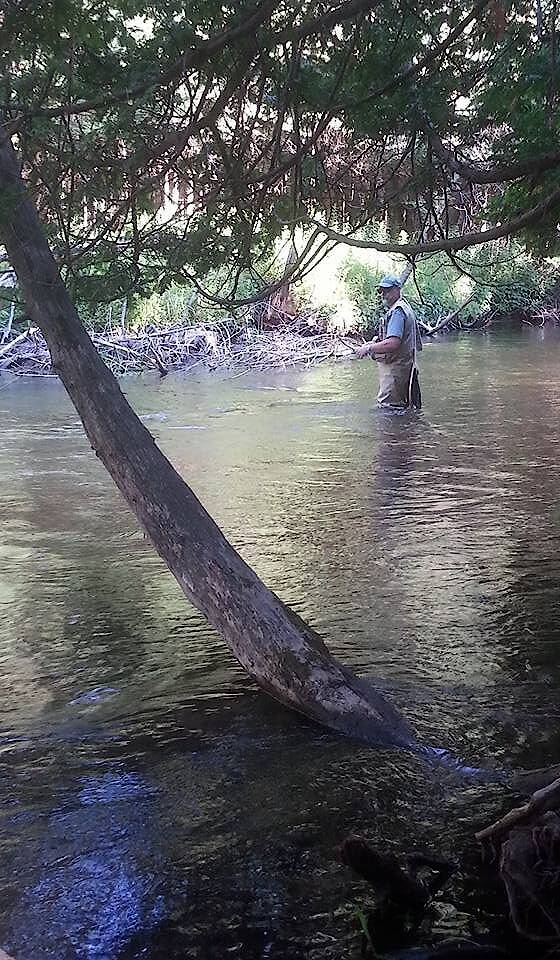
Salmonflies
Pteronarcys californica
The giant Salmonflies of the Western mountains are legendary for their proclivity to elicit consistent dry-fly action and ferocious strikes.
Featured on the forum

Troutnut is a project started in 2003 by salmonid ecologist Jason "Troutnut" Neuswanger to help anglers and
fly tyers unabashedly embrace the entomological side of the sport. Learn more about Troutnut or
support the project for an enhanced experience here.
Roguerat on Nov 14, 2015November 14th, 2015, 3:45 am EST
Spence's comments on how slender a natural is vs. dubbed imitations (Baetisca aside!) has me wondering IF.
Say I'm tying a sz 12 Iso pattern on a std dry-fly hook, using 6/0 thread; would downsizing to a sz 14 1XF 3XL hook, 8/0 thread, and paying attention to dubbing buildup yield more realistic results? Would the hook-gap be sufficient, would it bend out, lots of IF stuff on my mind.
I know presentation plays a part regardless of a fly's appearance but I still wonder.
I checked this site for posts or threads on hook size and all but couldn't find anything.
Roguerat
'Less is more...'
Ludwig Mies Vande Rohe
Say I'm tying a sz 12 Iso pattern on a std dry-fly hook, using 6/0 thread; would downsizing to a sz 14 1XF 3XL hook, 8/0 thread, and paying attention to dubbing buildup yield more realistic results? Would the hook-gap be sufficient, would it bend out, lots of IF stuff on my mind.
I know presentation plays a part regardless of a fly's appearance but I still wonder.
I checked this site for posts or threads on hook size and all but couldn't find anything.
Roguerat
'Less is more...'
Ludwig Mies Vande Rohe
Catskilljon on Nov 14, 2015November 14th, 2015, 9:37 am EST
The idea of tying larger imitations on "smaller" hooks is valid for a few reasons. I tye my Iso's and March browns on 2X long hooks, usually one or 2 sizes smaller than "normal". A spring Iso is huge, at least they are in the Catskills and the March browns are almost as big. To tye an imitation the same size would require at least a #10 standard shank dry fly hook and possible an #8. By using a longer shank, smaller gape hook, you not only gain the floating benefits of a lighter diameter wire but since the bend is 40% of the weight on a standard hook, the smaller gape decreases the weight too.
You don't want to take this too far though, like tying the same fly on a #16 6X long hook as the benefits, while good on the floating side are greatly reduced on the hooking and landing a fish side. Long shanks and light wire is a poor combo when fish get over 17". Ask me how I know! CJ
You don't want to take this too far though, like tying the same fly on a #16 6X long hook as the benefits, while good on the floating side are greatly reduced on the hooking and landing a fish side. Long shanks and light wire is a poor combo when fish get over 17". Ask me how I know! CJ
Martinlf on Nov 14, 2015November 14th, 2015, 10:25 am EST
I tie larger dry patterns on 2XL hooks, mostly for the reasons CJ notes regarding weight and flotation. But in regards to refusals, at least for most fish, the hook doesn't appear to matter, otherwise we'd never catch a fish. It may for some, though. The owner of a local fly shop told me about getting multiple refusals with fish in a popular catch and release stream. So he cut the hook off and immediately started getting hits. I fish a few flies, mostly caddis, that are tied upside down, with the hook buried in a CDC wing, never to penetrate the meniscus or be seen by a fish. They seem to work well at times on fish that seem picky. Note, I say "seem." I think we exercise a good bit of of interpretation, and precious little scientific experimental design, in terms of evaluating how well things work in regard to our flies, especially our pet inventions. Also, as CJ notes, hooking and landing properties of hooks are significantly important to consider. I'm very fond of Tiemco 921's for small flies. The short shank provides a larger gap relative to the fly size. They are a bit heavy, but flies tied with them seem to float relatively well due to the small size. And they hook and hold exceptionally well. I've never had a bigger fish bend one.
"He spread them a yard and a half. 'And every one that got away is this big.'"
--Fred Chappell
--Fred Chappell
Roguerat on Nov 14, 2015November 14th, 2015, 11:36 am EST
This is good to know, and I plan on downsizing some of my dries this coming winter- I see a lot of time at the vise ahead, but that's good.
MI Iso's and March Browns are pretty much the same, 10's and 12's and some of the bigger flies I tye; Hexes and the bigger drakes are in a different class altogether but I see XL hooks working for these as well.
The Tiemco 921 is interesting in that it's 1X fine but 2X short, I need to look for these.
Which begs a whole 'nother topic on circle hooks and how they would work for flies...?
Roguerat
MI Iso's and March Browns are pretty much the same, 10's and 12's and some of the bigger flies I tye; Hexes and the bigger drakes are in a different class altogether but I see XL hooks working for these as well.
The Tiemco 921 is interesting in that it's 1X fine but 2X short, I need to look for these.
Which begs a whole 'nother topic on circle hooks and how they would work for flies...?
Roguerat
Oldredbarn on Nov 14, 2015November 14th, 2015, 1:44 pm EST
Rogue,
That mind of yours is always running isn't it?! :) Good stuff!
Spence
That mind of yours is always running isn't it?! :) Good stuff!
Spence
"Even when my best efforts fail it's a satisfying challenge, and that, after all, is the essence of fly fishing." -Chauncy Lively
"Envy not the man who lives beside the river, but the man the river flows through." Joseph T Heywood
"Envy not the man who lives beside the river, but the man the river flows through." Joseph T Heywood
Quick Reply
Related Discussions
Topic
Replies
Last Reply
Invitation to the 30th Slovenian Open Fly Tying Championship 2017
In General Discussion by Lucky_luke
In General Discussion by Lucky_luke
0
Jan 5, 2017
by Lucky_luke
by Lucky_luke
Invitation to the 32nd Slovenian Open Fly Tying Championship 2019
In General Discussion by Lucky_luke
In General Discussion by Lucky_luke
0
Jan 13, 2019
by Lucky_luke
by Lucky_luke
Invitation to the 33rd Slovenian Open Fly Tying Championship 2020
In General Discussion by Lucky_luke
In General Discussion by Lucky_luke
0
Jan 17, 2020
by Lucky_luke
by Lucky_luke





